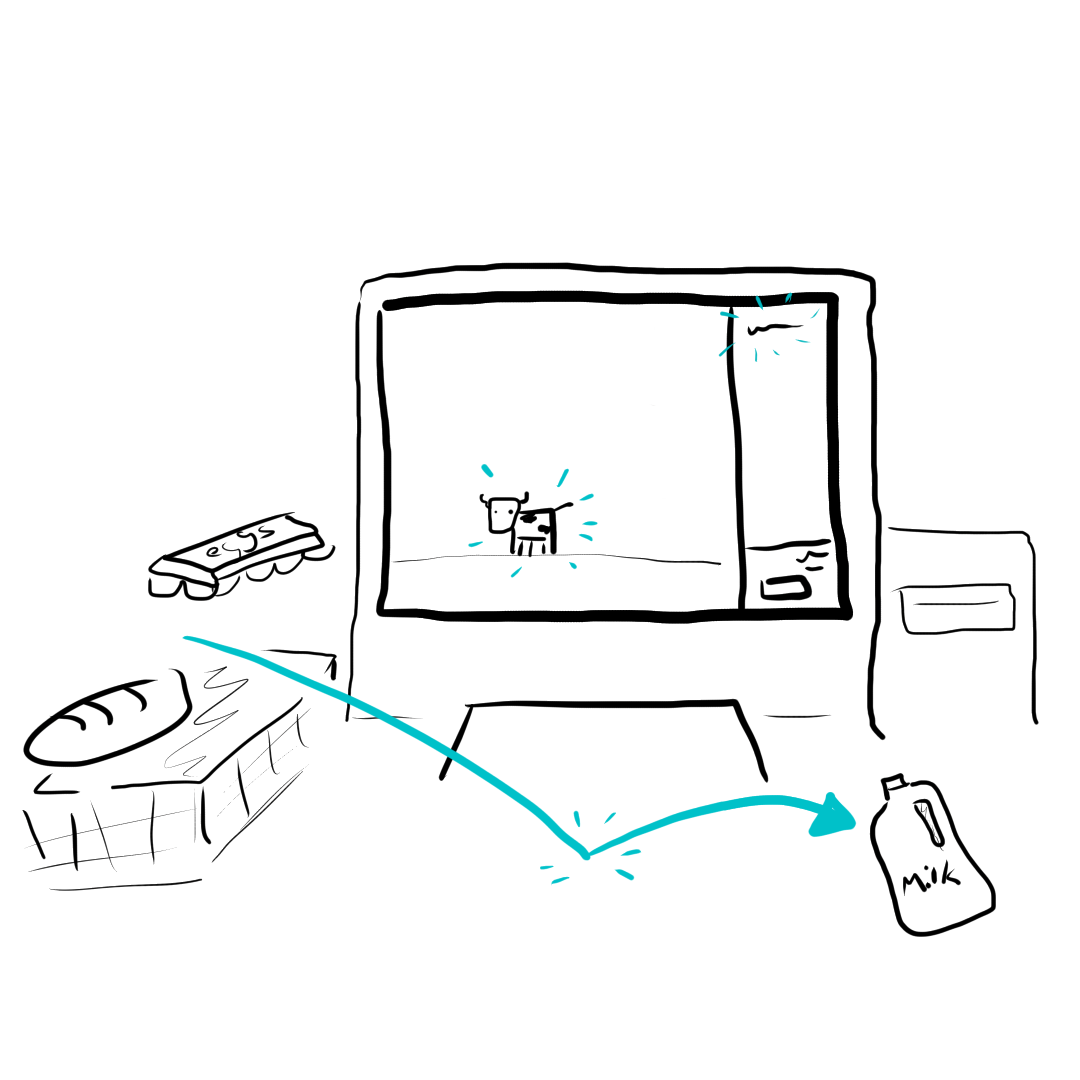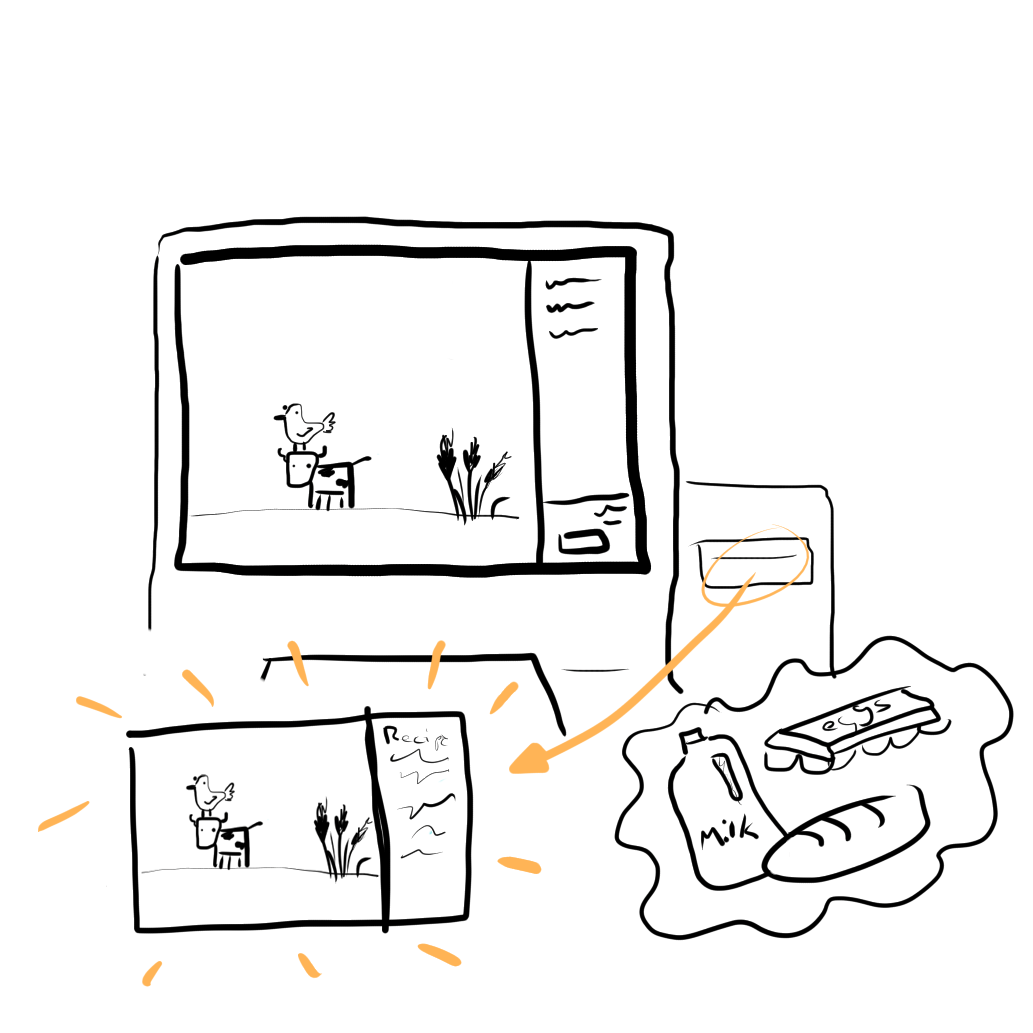Supporting family engagement during grocery shopping through embodied knowledge
Key Words: UX, Embodied Knowledge, Research, Observation, Group Project, Studio Project
Enhance the shopping experience of grocery shoppers by maximizing positive interactions, while considering tradeoffs between patron convenience and potentially reduced sales, as well as the ways in which technology may disrupt current monetization strategies
Our final proposed product is an enhanced self-checkout feature: a “family-mode” feature which creates a “scene” on the screen as items are scanned, along with a recipe involving those items. In addition to engaging adults and children, our research found that early engagement in this manner often leads to healthy, lifelong habits.
2 weeks
User Research
UX Design
Prototyping
Usability testing and Evaluation
Rachel Anderson (UX Designer)
Christopher Wolford (UX Designer)
This project centered around improving the grocery shopping experience through observation and understanding of embodied knowledge. In our case, we focused on encouraging family interaction specifically between parents and children.
Early research and investigation of literature presented several opportunities to explore cooperation and constructive positions in family co-shopping. As a group, we discussed how this challenged our own ideas about the role children play in the grocery shopping experience and wanted to learn more.
This research was supported through our first round of interviews. When asked about grocery shopping as a child, one interviewee, a self-described grocery store enthusiast, recalled the following:
“As a small child, I used to go grocery shopping with my mom...we’d go every Saturday or Sunday [when I was really little]. We would sit in the kitchen and open the pantries. I mean, she was a mom with three kids, plus a husband, so it was a much more expansive grocery list. And then we’d make the list [together].”
Another interviewee, an avid home cook, told us the following:
“I grew up in a house where my mom would cook and...listen to Dean Martin...and everybody would come into the kitchen and talk and listen to music. It just became this thing that I enjoy. So at the end of the workday, I can't wait to just....turn on some music and...cook”
In this situation, cooking was not just a means to an end. It was an opportunity for familial bonding.
We kept these anecdotes, and the rest of our research, in mind during our first contextual inquiry, a trip to Pay-Less at 8:30 AM, during which we observed several parents with children who seemed more like passive companions instead of active co-shoppers. Through observations of three various families, we noticed that during the shopping experience, children were relatively distracted whether they were eating a snack or hanging out in a cart. Thus, we began ideating on how to involve children during the shopping experience.
Our solution involves an enhanced self-checkout feature: “kid-mode” a feature which “paints” a scene on the screen as items are scanned, along with a recipe involving those items.
Let's take a closer look!
Upon arrival to a self-checkout machine, you’ll notice a new option: “kid-mode.” This offers a family-focused alternative to the typical checkout experience. If you’re shopping with your kids, simply select the option to begin!

As you and your kids scan groceries, the empty scene will populate with images related to the items you scanned. For example, scanning milk will add a cow, and scanning eggs will add a chicken. Don’t worry, all core self-checkout features are still present as you have fun creating a scene with your children.

Once all the groceries are scanned, and the payment is made, the scene you and your kids created gets printed alongside the receipt. Attached to the image is also a simple recipe using some of the ingredients you just purchased— providing yet another way to continue to engage with your children.

We tested Kid Mode through a usability test and evaluated it through an additional post-session interview to discuss their experience as well as the parent’s experience.
Following our usability test, we evaluated the experience with a post-session interview. Our follow-up questions to our users were simple in order to be cognizant of their age. The younger tester (age 3) responded to most questions with squeals of delight or a broad smile. The older tester (age 5) greeted each step of the usability test with smiles, concluding “it was cool.” While the questions above were met with one-word answers or nods, we learned more through our observation of the children engaging with Kid Mode., There were moments of joy showing on their faces as items “appeared” on the screen and the child was in complete control of which items to scan next. Furthermore, both users were focused on what was happening and the prototype was successful in holding their attention.

Finally, we discussed Kid Mode with a parent of one of the children; they described the follow in regarding Kid Mode:
“I would love this if this was at a grocery store! While I dolet my kids scan some items, I love the idea of taking home a recipe card thatwe can cook together when we get home.”
Furthermore, when it cameto the actual test, the parent let her child have complete control with littleguidance. We believe this level of trust and cooperation led to many moments ofdelight from the tester throughout the process.
If you would like to see the full project documentation, you can download it here!
While we are confident in our idea, we know there are some changes that must be made. Therefore, below are some proposed changes we would make:

We had set out to change the way families experience grocery shopping. From our research, testing, and analysis; we believe our solution encourages stronger engagements between parents and children that extend past the grocery shopping trip. Although obvious limitations still need to be addressed within our solution, the changes we made integrate seamlessly in the current environment without degrading the shopping experience for other shoppers. Through each stage of the project’s development, we were driven with purpose﹣ from discovering an opportunity in the current setting of grocery shopping to effectively developing a strategy for promoting interactions the space is currently deprived of.